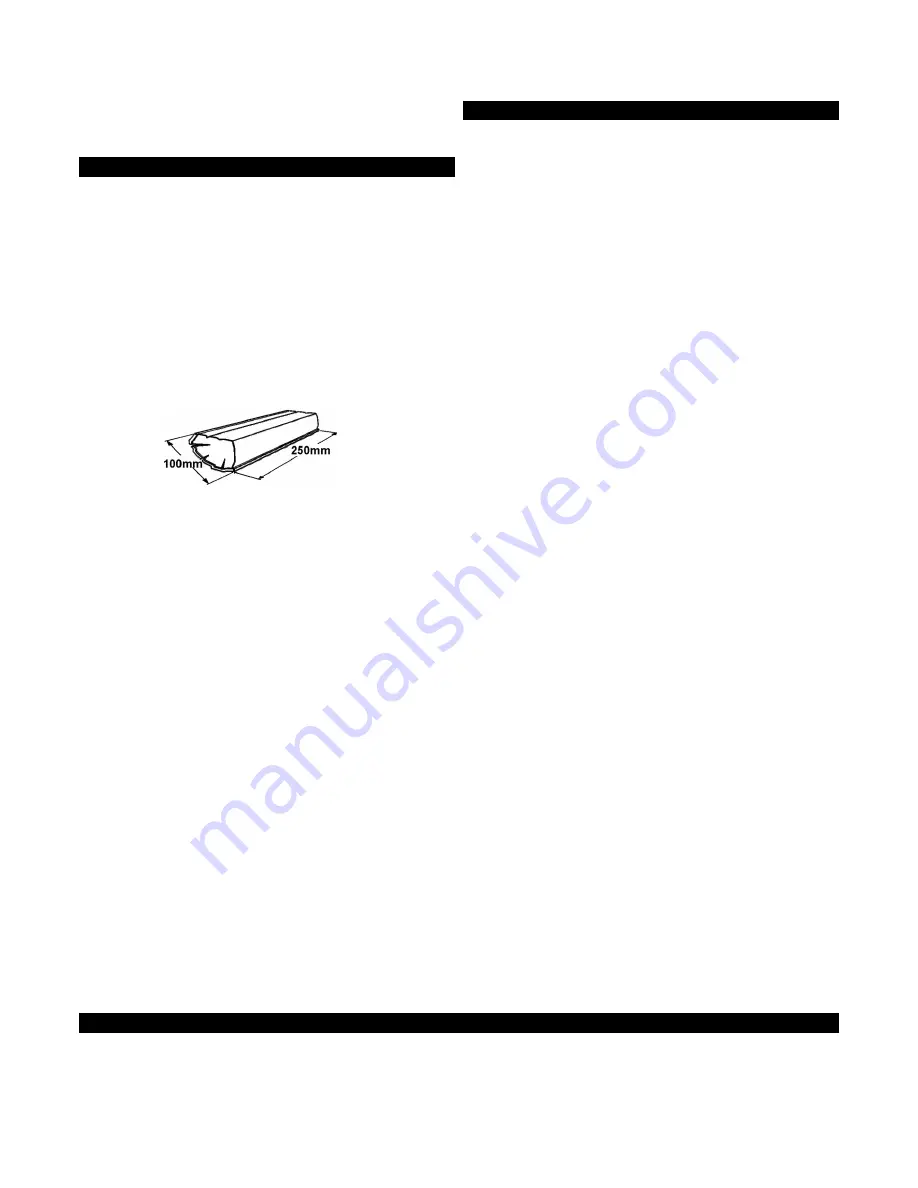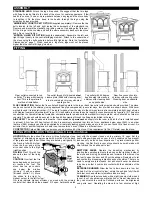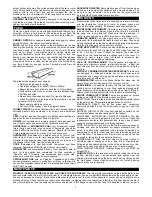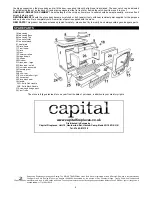
output will usually burn-off any window deposits left by tarry or wet
fuels. After a period of use tiny hairline cracks may appear on the
window, this is not a fault and will not increase the risk of
breakage but is a characteristic of the toughest and most heat-
resistant material currently available.
OPENING THE DOOR
This stove is designed to be operated only
with the door closed. Open the door slowly when refuelling or de-
ashing to minimise fume emission.
FUELS
There is no 'perfect' fuel, so we strongly recommend that you try a
selection of fuels (or mixtures) to find which suits you best. Do
avoid dusty materials like sawdust, they can burn far to violently.
SMOKE CONTROL:
In certain areas special rules apply to reduce
smoke nuisance. Check with your local authority.
WOOD
only emits as much carbon to the atmosphere as the tree
took in when growing, so wood is considered the 'carbon neutral'
fuel. When wood is cut down its cells are full of water. Burning
such wet or 'green' wood wastes heat in making steam and
produces flammable, acidic tars which will cling to, and can
damage, your stove and chimney. Logs should be split lengthways
and dried for at least a year. The fine, white residue produced
when wood burns is not ash, but the remains of cell walls which
can burn if kept hot enough, so don't de-ash a wood fire until
absolutely
necessary.
Minimise smoke emission from wood by:
Split logs lengthways for drying
Use logs no bigger than about 100mm x 250mm
Ensure logs are
absolutely dry
(less than 15% moisture)
Fill the stove criss-cross, so air can circulate between logs.
Fill 'little and often'
Always have the airwash control (2) at least a little open.
When first lighting, or reviving a fire from embers, use only
very small, thin, dry, sticks.
Never operate with the door open.
Don't overfill the firebox – see the diagram above.
JOINERY WASTE
Dry wood offcuts will burn well, but don't expect
softwood waste to burn as cleanly or for as long as dry hardwood
logs.
PEAT:
Sod turf must be thoroughly dry. BNM peat briquettes are
approved for use in Smokeless Zones in the RoI.
LIGNITE
(not smokeless) is a natural mineral, between peat and
coal. It lights easily and burns well, but produces much ash
HOUSECOAL
or
BITUMINOUS COAL
(not smokeless) makes
lots of tarry smoke and large volumes of flammable gas which
make it difficult to control and risk explosions. Despite its low cost,
it rarely represents value for money. Don't use housecoal.
ANTHRACITE
(Smokeless) is a natural hard, shiny form of coal.
Slow to light, it can burn for very long periods with great heat.
Despite its high price-per-bag it generally works out to be one of
the cheapest of all fuels. Use the 'small nuts' size.
COKE
(Smokeless) is coal from which the smoke has been
removed. Sometimes difficult to light, it burns very cleanly.
BRIQUETTES
Are compressed blocks of fuel, generally able to
burn for long periods and remarkable for their consistency.
'Homefire' and 'Phurnacite' are smokeless types while other
brands are made from lignite, peat or housecoal.
PETROLEUM COKE
sold as 'Petcoke', 'Longbeach' and under
various proprietary names, is made from oil. Easy to light and to
control, its exceptional heat and lack of protective ash mean that it
MUST NOT be used.
HOUSEHOLD WASTES
Some plastics give off toxic fumes when
burned and remember that batteries and aerosols explode! The
stove is not an incinerator, so only ever use the recommended
fuels and NEVER use liquid fuels in any form.
PROBLEMS
Problems like those listed here are usually due to some difficulty
with the installation, chimney or fuels, so please check back
through this leaflet carefully. If necessary seek specialist advice.
SMOKE FROM THE CHIMNEY
It is quite normal for a little smoke
to be emitted from the chimney when the fire is cold, so, start the
fire using only a very little fuel. Make sure that the airwash
control is open and use only VERY dry wood or smokeless fuels.
DAMAGED LINERS
Your stove gets very, very hot inside, it is
quite usual for the replaceable liners to crack or craze. They need
only be replaced when they have almost completely disintegrated.
Help them last longer by using only
very
dry
fuel.
POOR HEAT OUTPUT:
A stove can heat a typical room of
about
12m³ volume for each kW of output, so a 5kW model can heat up
to (12 x 5) 63m³, a room of about 5m square. The actual size
depends on the insulation and air-change ratio of the room. To
attempt to heat a larger room will result in excessive fuel
consumption and damaging overheating.
LACK OF CONTROLLABILITY
This appliance is designed to
always burn vigorously enough to eliminate smoke - adjust the
heat output by how much fuel you put on, as well as by using the
controls.
DIFFICULTY BURNING FOR EXTENDED PERIODS
This stove is
not designed for extended burning but for quick heat-up and
occasional use. Longer burning can be achieved only using very
hard fuels such as anthracite.
CONDENSATION
onto cool surfaces inside the stove can be
severe if fuel is in any way damp.
Use only very dry fuel.
OVER-FIRING:
It is possible to leave the fire too long with the
controls set too high leading to 'over firing', seen as glowing metal
parts, excessive chimney temperature and risk of parts failing or
chimney fires. Always set controls to the lowest practical setting.
SMOKE COMING INTO ROOM
Fumes are poisonous- smoke
emission must NEVER be tolerated, causes might be:
NEW STOVE: There is often a smell and sometimes visible fumes
as the paint cures. This normally stops after an hour or so.
INADEQUATE SEALS: Are all flue pipes and connectors
absolutely
gas-tight? Even the tiniest crack or gap can spoil the
draught.
BLOCKED THROAT PLATE: Has soot and ash collected on the
'throat plate' above the inner back part of the firebox?
UNSUITABLE, BLOCKED OR UN-SWEPT CHIMNEY: The first
requirement for correct operation is a sound chimney. Check the
requirements earlier in this document and in any case of doubt
engage a professional sweep or chimney engineer.
POOR AIR SUPPLY: Lack of air to the fire is a common cause of
smoking and poor performance. Air supply problems may be
worse in certain wind conditions (often incorrectly ascribed to
'downdraught', which is in fact very rare), where air can be sucked
out of the room. The answer is to fit an air vent, as near to the fire
as possible, facing into the usual wind direction.
DOWNDRAUGHT: Wind can blow
down
a chimney if there is
something higher nearby such as a tree, hill or high building.
Fitting an anti-downdraught cowl to the chimney top can cure this.
Types which cannot be swept through are not recommended.
POOR CHIMNEY DRAUGHT- Chimney draught in use MUST be
at least 12Pa.
CHIMNEY FIRE:
In the rare event of deposits inside the chimney
igniting (roaring sound + dense smoke and sparks from the
chimney) immediately close the door, shut all air controls and call
the fire brigade. Prevent fires by using
very dry fuel
and having
your chimney swept regularly.
MAINTENANCE
MONTHLY- CLEAN THE THROAT PLATE and CHECK THE DOOR SEALS
The throat plate (sometimes called a baffle plate) is the
cast-iron plate inside the roof of the stove, item (9) in the diagram below. It serves to distribute flames towards the sides and top of the
fire and so increase heat output. Remove the plate when the stove is cool to brush off any deposits of soot or ash which might cause a
blocked chimney. Check that the door seals are undamaged, (replacing them if necessary) and that they fully seal against the stove
body. After a period of use the seals can become compressed - if this happens, open the door and lift it upwards to remove, screw in
3






















